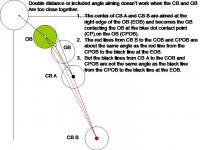Hi Jeff,
I am stunned by your reply. I do believe that throw has a certain minimal effect but by a whole 23 degrees for a half -ball aim, that is astonishing (or rather shocking).
May I know how the test is done and how sure are you that you are hitting the exact spot on the half-ball aim point each time? I am concern especially since I hope to use the half-ball aim as one of my three aiming points.
Thanks for the heads up.
I am stunned by your reply. I do believe that throw has a certain minimal effect but by a whole 23 degrees for a half -ball aim, that is astonishing (or rather shocking).
May I know how the test is done and how sure are you that you are hitting the exact spot on the half-ball aim point each time? I am concern especially since I hope to use the half-ball aim as one of my three aiming points.
Thanks for the heads up.
